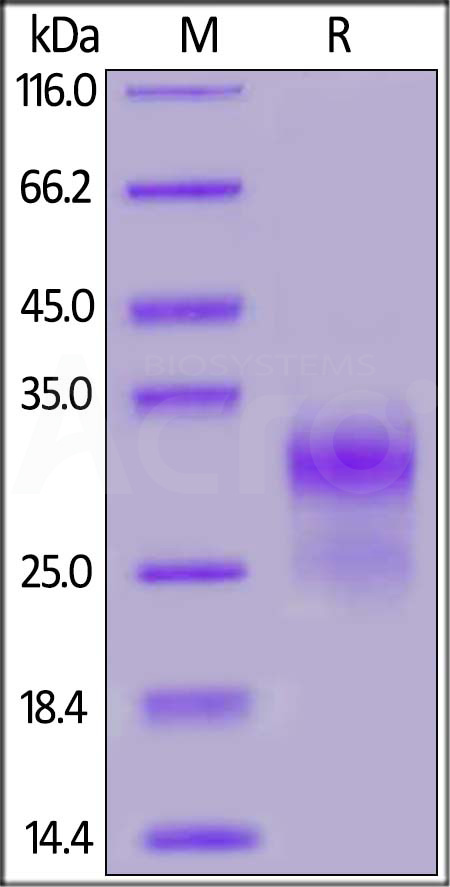分子别名(Synonym)
SOST,VBCH
表达区间及表达系统(Source)
Human SOST, His Tag (HST-H5245) is expressed from human 293 cells (HEK293). It contains AA Gln 24 - Tyr 213 (Accession # AAI01087.1).
Predicted N-terminus: His
Request for sequence
蛋白结构(Molecular Characterization)

This protein carries a polyhistidine tag at the N-terminus
The protein has a calculated MW of 22.3 kDa. The protein migrates as 30-34 kDa under reducing (R) condition (SDS-PAGE) due to different glycosylation.
内毒素(Endotoxin)
Less than 1.0 EU per μg by the LAL method.
纯度(Purity)
>90% as determined by SDS-PAGE.
制剂(Formulation)
Lyophilized from 0.22 μm filtered solution in PBS, pH7.4 with trehalose as protectant.
Contact us for customized product form or formulation.
重构方法(Reconstitution)
Please see Certificate of Analysis for specific instructions.
For best performance, we strongly recommend you to follow the reconstitution protocol provided in the CoA.
存储(Storage)
For long term storage, the product should be stored at lyophilized state at -20°C or lower.
Please avoid repeated freeze-thaw cycles.
This product is stable after storage at:
- -20°C to -70°C for 12 months in lyophilized state;
- -70°C for 3 months under sterile conditions after reconstitution.
电泳(SDS-PAGE)

Human SOST, His Tag on SDS-PAGE under reducing (R) condition. The gel was stained with Coomassie Blue. The purity of the protein is greater than 90%.
活性(Bioactivity)-ELISA

Immobilized Human SOST, His Tag (Cat. No. HST-H5245) at 5 μg/mL (100 μL/well) can bind Human LRP-6 (20-630), Mouse IgG2a Fc Tag (Cat. No. LR6-H5253) with a linear range of 10-78 ng/mL (QC tested).
Protocol
背景(Background)
Sclerostin (SOST) is also known as Sclerosteosis, VBCH, is a secreted glycoprotein with a signal peptide for secretion and a C-terminal cysteine knot-like (CTCK) domain and belongs to the Cerberus/DAN family of bone morphogenetic protein (BMP) antagonists. Sclerostin is produced by the osteocyte and has anti-anabolic effects on bone formation. More recently Sclerostin has been identified as binding to LRP5/6 receptors and inhibiting the Wnt signalling pathway. Wnt pathway inhibition under these circumstances is antagonistic to bone formation (meaning Sclerostin antagonizes bone formation). It has been shown that SOST binds BMP-5, -6, and -7 with high affinity and BMP-2 and -4 with low affinity. Sclerostin production by osteocytes is inhibited by parathyroid hormone, mechanical loading and cytokines including oncostatin M, cardiotrophin-1 and leukemia inhibitory factor. Sclerostin production is increased by calcitonin. Thus, osteoblast activity is self regulated by a negative feedback system. Mutations of Sclerostin is associated with the syndrome Sclerosteosis, and reduced sclerostin expression results in a milder form of the disorder called van Buchem disease.






















































 膜杰作
膜杰作 Star Staining
Star Staining











